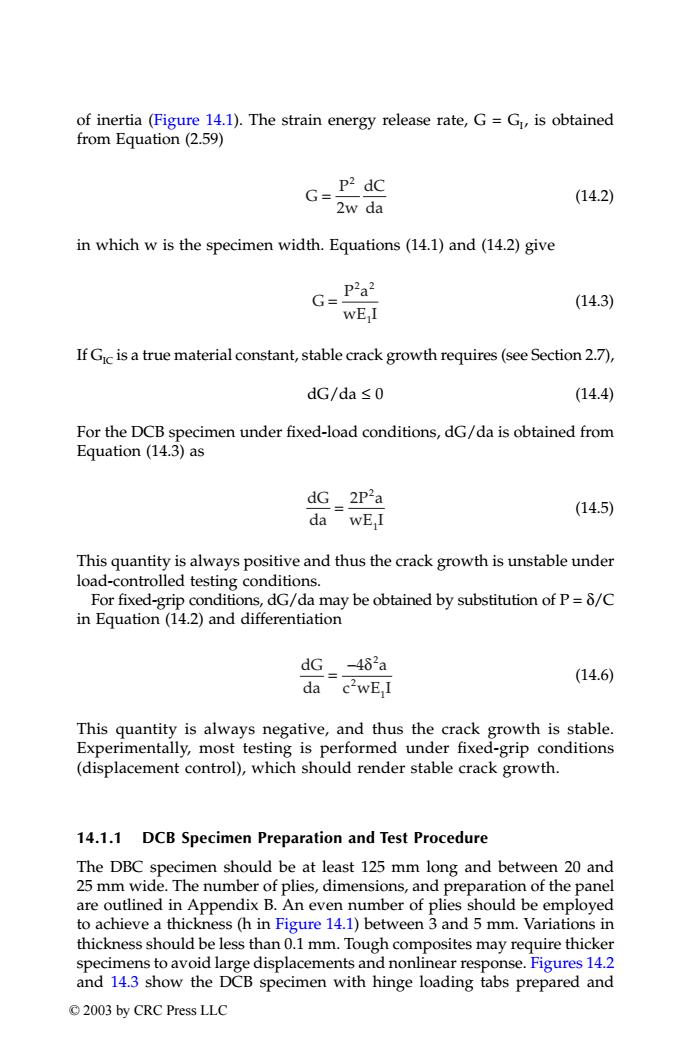正在加载图片...

of inertia(Figure 14.1).The strain energy release rate,G=G,is obtained from Equation (2.59) G= P2 dC (14.2) 2w da in which w is the specimen width.Equations (14.1)and (14.2)give G=Pa2 (14.3) wEI If Gic is a true material constant,stable crack growth requires(see Section 2.7), dG/da s0 (14.4) For the DCB specimen under fixed-load conditions,dG/da is obtained from Equation (14.3)as dG 2P2a (14.5) da wE,I This quantity is always positive and thus the crack growth is unstable under load-controlled testing conditions. For fixed-grip conditions,dG/da may be obtained by substitution of P=8/C in Equation(14.2)and differentiation dG_-462a (14.6) da c'wE I This quantity is always negative,and thus the crack growth is stable. Experimentally,most testing is performed under fixed-grip conditions (displacement control),which should render stable crack growth. 14.1.1 DCB Specimen Preparation and Test Procedure The DBC specimen should be at least 125 mm long and between 20 and 25 mm wide.The number of plies,dimensions,and preparation of the panel are outlined in Appendix B.An even number of plies should be employed to achieve a thickness (h in Figure 14.1)between 3 and 5 mm.Variations in thickness should be less than 0.1 mm.Tough composites may require thicker specimens to avoid large displacements and nonlinear response.Figures 14.2 and 14.3 show the DCB specimen with hinge loading tabs prepared and ©2003 by CRC Press LLCof inertia (Figure 14.1). The strain energy release rate, G = GI, is obtained from Equation (2.59) (14.2) in which w is the specimen width. Equations (14.1) and (14.2) give (14.3) If GIC is a true material constant, stable crack growth requires (see Section 2.7), dG/da ≤ 0 (14.4) For the DCB specimen under fixed-load conditions, dG/da is obtained from Equation (14.3) as (14.5) This quantity is always positive and thus the crack growth is unstable under load-controlled testing conditions. For fixed-grip conditions, dG/da may be obtained by substitution of P = δ/C in Equation (14.2) and differentiation (14.6) This quantity is always negative, and thus the crack growth is stable. Experimentally, most testing is performed under fixed-grip conditions (displacement control), which should render stable crack growth. 14.1.1 DCB Specimen Preparation and Test Procedure The DBC specimen should be at least 125 mm long and between 20 and 25 mm wide. The number of plies, dimensions, and preparation of the panel are outlined in Appendix B. An even number of plies should be employed to achieve a thickness (h in Figure 14.1) between 3 and 5 mm. Variations in thickness should be less than 0.1 mm. Tough composites may require thicker specimens to avoid large displacements and nonlinear response. Figures 14.2 and 14.3 show the DCB specimen with hinge loading tabs prepared and G P w dC da = 2 2 G P a wE I = 2 2 1 dG da P a wE I = 2 2 1 dG da a c wE I = −4 2 2 1 δ TX001_ch14_Frame Page 187 Saturday, September 21, 2002 5:09 AM © 2003 by CRC Press LLC